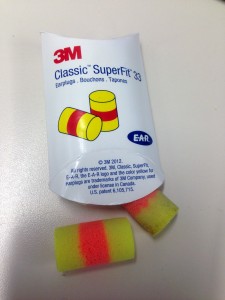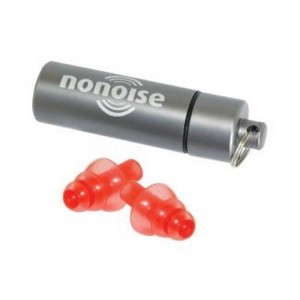There are many activities where the use of hearing protection is now standard practice. It has been prevalent for construction and  factory workers for years as well as required for those who participate in target shooting at an organized club or range. Lawn and tree care professionals and many homeowners wear hearing protection when cutting grass or operating chain saws.
factory workers for years as well as required for those who participate in target shooting at an organized club or range. Lawn and tree care professionals and many homeowners wear hearing protection when cutting grass or operating chain saws.
These types of sustained noises cause hearing damage very slowly, over a period of time. You may not ever notice until it is too late. When I was younger I never considered hearing loss and now I suffer with tinnitus. I have been exposed to loud sound as a drummer and attending many clubs and concerts. But how many of us consider that riding a motorcycle can also be a significant contributor lead to permanent hearing loss as well?
There are high levels of noise associated with riding. This is not a new subject and there has been plenty written up about it on. I’ve read that noise levels over 85 dB can damage hearing, and that some motorcycles at idle generate around 80 dB of sound.
Once moving there is a lot of wind noise, and the sound level rises dramatically to 115 dB or more. This type of noise exposure can begin to cause hearing damage in less than 30 minutes. Wearing a helmet or having a fairing or windshield can lessen the noise intensity, but the noise is still there and loud enough to be an issue. This is not a “might happen” situation. Prolonged wind noise exposure will cause hearing loss.
The use of hearing protection is doctor recommended to reduce the risk of hearing loss due to excessive levels of noise; which includes wind noise while riding. I’ve began riding with earplugs when I noticed I was having hearing loss issues.
At highway speeds winds noise frequencies are reduced sufficiently so that it may help hear other important sounds. Reduction in wind noise can also help reduce noise induced fatigue. Standard disclaimers apply. Choosing to ride with ear plugs is a personal decision.
Ear plugs come in all shapes, sizes and costs. It is best to try different ones to determine which ones fit and work best for you. Select ones that provide sufficient noise suppression. The suppression level or NNR value is typically printed on the packaging. Attenuation levels at frequencies across the sound spectrum are indicated by graph or numeric.
Foam plugs are the most common and the least costly. They come in different shapes and sizes, and cost around $1 or so per pair. They will get dirty from use and will need to be replaced more often than you might think.
Silicone plugs last longer, and can be cleaned, but do cost a bit more. On the high end of the cost spectrum are custom molded ear plugs made by professional audiologists. Being somewhat frugal I’ve tried all but the expensive custom molded types, but I’ve been told by users that they work well. Putting them in and out takes practice.
 There are specialized earplugs, both off-the-shelf silicone and custom, that incorporates tiny speakers to make an earplug headset. These can be plugged directly into an MP3 player or communications system. They reduce wind noise and make it easier to hear what you want to listen to. Check local laws as they pertain to wearing earplugs and headsets while riding. Also, be sure to read and follow proper use instructions for the ear plugs worn.
There are specialized earplugs, both off-the-shelf silicone and custom, that incorporates tiny speakers to make an earplug headset. These can be plugged directly into an MP3 player or communications system. They reduce wind noise and make it easier to hear what you want to listen to. Check local laws as they pertain to wearing earplugs and headsets while riding. Also, be sure to read and follow proper use instructions for the ear plugs worn.
Basic foam ear plugs attenuate the entire audio frequency spectrum. Some better silicone ear plugs use a internal filter that attenuate wind noise frequency spectrum more than other sounds. I’ve been using one such brand recently called NoNoise. They manufacture earplugs using a ceramic filter, and offer a range of products with different tuned filters for different uses – work, shooting, etc. as well as motorsports. I found them online at Twisted Throttle.
After using them on an 800-mile road trip I can say that they are better than using the cheap foam plugs. They are more comfortable, but more important was that the filter provided attenuation of wind noise, while making it easier to hear normal speech compared to foam plugs. One negative thing I found is that the plug stem is a bit too short, making removal a bit more challenging.
Do you ride with hearing protection? What are your thoughts one this?
 Ride CT & Ride New England Serving New England, NYC and The Hudson Valley!
Ride CT & Ride New England Serving New England, NYC and The Hudson Valley!



Just started wearing ear plugs and I’ve been surprised how much they help. Currently using cheap foam plugs but the do a great job taking out the wind buffeting noises especially at highway speeds. I’ve also found they improve the bass sound on my internal helmet speakers.. I ride a GL1800 and never thought I would need ear plugs with a big windshield but now I find them a must have at highway speeds and nice to have for general riding to get better base sounds from my music.
I recently had a chance to try NoNoise motorsports earplugs, and I found them to be inadequate. They didn’t really attenuate the wind noise under my Shoei Neotec helmet very much. I’m now back to cheap foam earplugs. When they’re inserted properly they do a great job on wind noise. I can still hear everything around me well enough. In my case, I have very acute basic hearing (my other major interest is chamber music, e.g., string quartets, etc., so I value my hearing a lot). On the other hand, if your basic hearing is already compromised, then you might have to be concerned that the foam earplugs cut out too much sound.